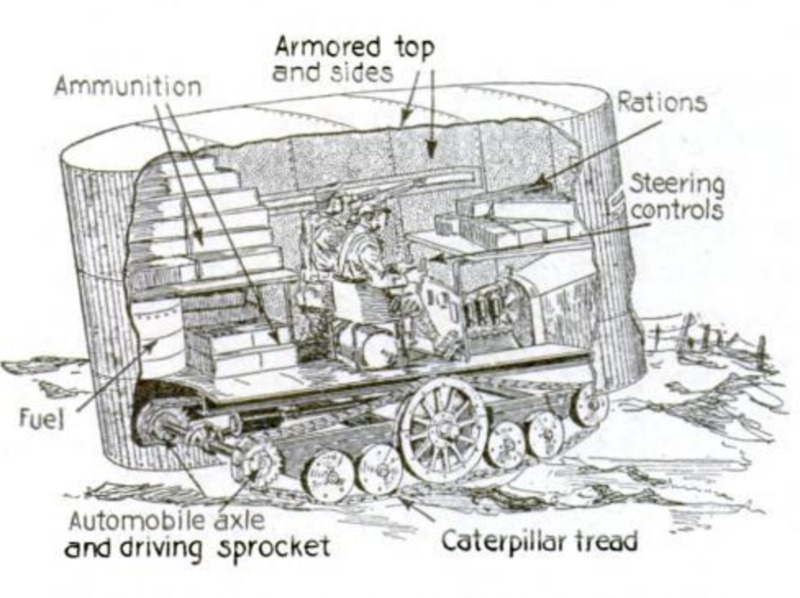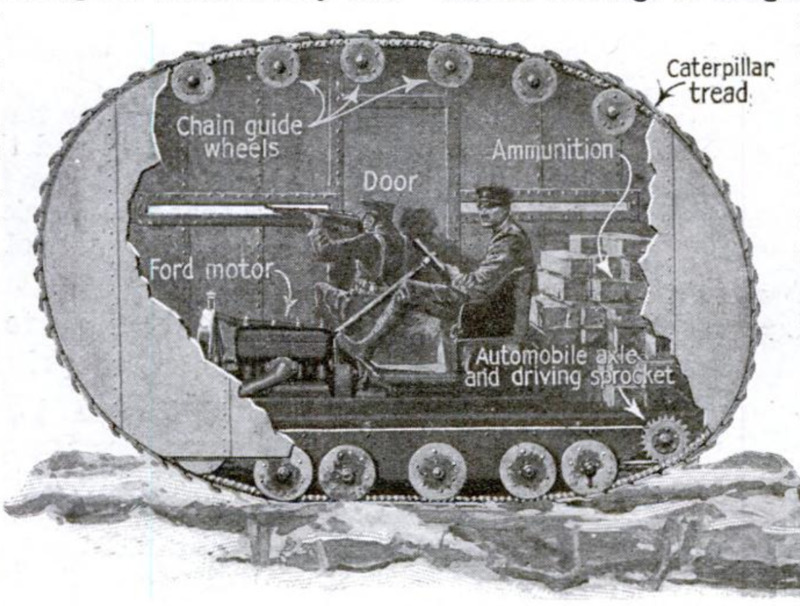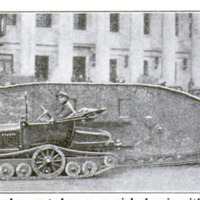Ford Tank
Contenuto
-
Titolo
-
Ford Tank
-
Article Title and/or Image Caption
-
Ford's Artificial Armored Horse. The new two-man tank designed to take the place of cavalry
-
extracted text
-
CAVALRY is almost as extinct as the Dodo or the Mammoth. The machine gun, barbed wire, shells that bury themselves twenty feet in the ground and then explode are responsible for the passing of the trooper. Horses cannot be used to advantage in shell-pitted territory and against a hail of machine gun bullets. No adequate method has been devised up to the present time to protect the horses against rifle and machine gun bullets, shell splinters and shrapnel. And so military men have had to invent an artificial armor-protected horse—the two-man tank, which is light, mobile, fast as a horse, and which wriggles in and out of shell craters with astonishing ease.
The two-man tank has been linked up with the name of Ford because it is proposed to use Ford engines to supply its power. It is the invention of C. H. Martin of Springfield, Mass., who has already constructed three of the units with the exception of the armor.
The first of the two-man tanks to be seen in public was shown recently in Springfield, Mass. In the accompanying picture it stands by the side of one of the British tanks. It is about one-half the length of the big tank and consists of a Ford power-plant mounted on a sub- frame. The driving sprocket is at the rear end, and on each side there is a big tread wheel in the center, with two smaller idlers in front and two in the rear. The armor of this small tank weighs about 1200 pounds. At the present time no definite description can be given of the armor, but it is stated that each tank will carry two machine guns and will be able to travel at a speed of twelve miles an hour over fairly smooth ground and with half that speed over shell-scarred terrain.
It is claimed in favor of the small tanks that, because of their lesser weight they can go to places which the big tanks could not reach. It is also argued that a larger number of small tanks can do more damage than a smaller number of large tanks and at smaller expense. The armor of these two-man tanks 1s intended to deflect machine-gun-fire. Their speed will make it possible to use them in place of cavalry for quick dashes into the enemy’s country.
It has been rumored that these tanks will be more like giant wheels than the familiar elongated British tanks. Hence they may resemble the tank shown in the accompanying sketch, in which the caterpillar treads are run completely around the circumference of the wheel, the inner portion of the wheel being armored and remaining stationary.
Another possibility is that the new tanks will be patterned after the latest French tanks in which the caterpillar treads extend along the bottom only and are partly protected by the side armor. In that case the front and rear ends will be beveled to give the machine gunner and the operator a clear view for sighting their guns. In either case the tank will be steered by a modified Ford control to permit of stopping and starting either tread at will. If the French type of armoring is used, the tread could be arranged as shown in one of the pictures.
The tank as a war machine is, like so many other new inventions, still in an experimental state. But it has proved itself so useful already that it will undoubtedly be made a part of the equipment of every army, although its structure may vary.
-
Lingua
-
eng
-
Data di rilascio
-
1918-08
-
pagine
-
250-251
-
Diritti
-
Public Domain (Google digitized)
-
Archived by
-
Filippo Valle
-
Alberto Bordignon (Supervisor)





